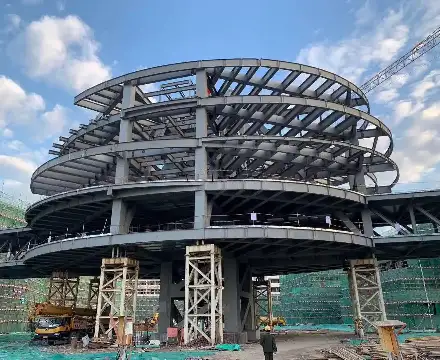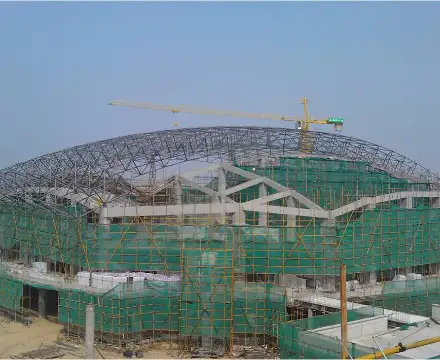In the calculation of steel structure engineering quantity, attention should be paid to cleaning and checking the number of drawings according to the drawing catalog, and checking whether there are any omissions; building construction drawings; structural construction drawings; matters that should be paid attention to in the calculation process.

Drawings: According to the drawing catalog, clean up and check the number of drawings and check whether there are any omissions.
Building construction drawings
General description of design
- Building area, structural form, column spacing, span, and structural arrangement;
- Scope of engineering quantity calculation: Regarding the structure, roof, wall, doors and windows, etc., be clear about the scope of bidding quotation;
- Selection of materials, specifications, models, and technical requirements;
- Paint or coating requirements and fire rating of steel structures.
Floor plan, elevation, section
It can count the engineering quantity of doors and windows, indoor and outdoor steel ladders, roof color panels, lighting panels, wall color panels, roof ventilators, canopies, downpipes, edge closing flashing parts, gutters, etc. When making statistics, the material, specification and model of each material should be indicated.
Structural construction drawings
General description of structural design
- Material: The material corresponding to the components of each part (steel column, beam, purlin, support, etc.), such as Q235, Q345, strength grade requirements of high-strength bolts, etc.;
- Welding quality requirements: welding seam quality grade, non-destructive testing requirements, such as splicing weld quality grade should reach the first level, requiring 100% flaw detection, second-level weld 20% flaw detection, involving the calculation of non-destructive testing costs;
- Derusting requirements: Derusting by hand and power tools (St), jetting or projecting (Sa). Different rust removal grades have different rust removal costs;
- Requirements for paint (painting): the type of paint, the number of brushing times, the thickness of the paint film, the fire rating, and the fire resistance limit of each part.
Floor plan, elevation, section, node details:
The following engineering quantities can be calculated in sequence:
- Pre-embedded iron parts: including pre-embedded positioning plates, pre-embedded bolts and nuts;
- Steel columns, wind-resistant columns, steel beams, crane beams;
- Roof support, tie rod, inter-column support, canopy frame;
- Roof purlins, wall purlins, corner braces and tie rods of roof and wall purlins;
- During the calculation process, pay attention to the calculation of the engineering quantities of the connecting parts of the crane beam and the column, the backing plate, the purlin support plate of the roof and the wall, the connecting plate of the corner bracing and the steel column and beam, the steel casing of the tie rod, etc. Pay attention to the number of high-strength bolts;
- If a material table is listed in the drawing, you can check whether the size, specification and quantity of the parts in the table are accurate according to the part numbers listed in the material table, and whether there is any undercount, omission or miscalculation;
- Pay attention to whether there are design changes and modifications, supplementary explanations, answering questions, etc.

Matters needing attention in the calculation process
About the format of engineering quantity calculation
- The unit of weight of the steel structure is kg, the unit of area is m2, and the unit of length is m, and the calculation results are kept to one decimal place;
- When calculating the weight of a component, the parts of the component can be numbered from bottom to top, left to right, and calculated in this order.
The format of the calculation formula:
1.Plate: Specification × Length × Width × Quantity
For example -6×500×300×5, it means that the plate thickness of the part is δ=6mm, the plate length is 500mm, the width is 300mm, and the quantity is 5 pieces.
The weight calculation formula is: 6×0.5×0.3×7.85×5=35.3kg
2.Profile: specification, length × quantity × specific gravity
For example, L50×5, L=3500mm×5×3.77, means equilateral angle steel with leg width of 50mm, length of 3500mm, quantity of 5 pieces, and specific gravity of 3.77kg/m.
The weight calculation formula is: 3.5×5×3.77=66.0kg
Points to note when calculating the size
- Pay attention to the elevation value of indoor and outdoor and steel column bottom plate, whether it is ±0.00 or other elevation value. When calculating the length (or height) with the elevation value, special attention should be paid not to calculate by ±0.00;
- Regarding the calculation of the height (or length) of the stiffening plates, purlin corner braces, and parapet fascia brackets corresponding to the variable H-section members (beams, columns), the calculation can be based on the average H-section height of beams and columns;
- The length of the roof purlins is calculated according to the overall length, without deducting the gap between the purlins. In addition, it is necessary to add the length of the purlins occupied by the roof beams at the gable wall. For example, if the axis represents the center line of the roof beams, then: purlins The length of = axis length + roof beam width;
- In the calculation of wall purlins, attention should be paid to whether the door posts and door beams are double purlins, and whether there are double purlins in other parts;
- The length of the tie rod is calculated by adding 50mm to each end of the corresponding purlin spacing, and the length of each tie rod is increased by 100mm.
Calculation of edge closing flashing
- Calculation scope: roof ridge cover plate, flashing plate at the interface between gutter and roof plate and parapet, flashing plate at the interface between gable and roof plate, roof flashing plate at the upper part of parapet, sillage at the corner of the wall. Edge panels, edge trim panels around doors and windows, flashing panels at the junction between wall panels and brick walls, flashing panels at the junction between wall and canopy, and edge trim panels around the canopy. If it is a double-layered board, the edge trims at each interface of the inner panel of the roof and the inner panel of the wall shall be calculated separately;
- About the width of the edge-receiving flashing plate: In general, the unfolded width of the edge-receiving flashing piece can be calculated as 300~400mm, and the unfolded width of the parapet top and roof ridge cover is calculated as 500~700mm. In actual calculation, it can be calculated according to the corresponding joint details of the design;
- For the webs of beams and columns with variable cross-sections, the weight shall be calculated according to the net weight during bidding, subcontract settlement, and cost calculation, and shall be calculated according to the circumscribed rectangle during settlement with Party A. Various connection boards are calculated according to the circumscribed rectangle.
The part that cannot be counted repeatedly
- High-strength bolts: The connection between columns and beams and the connection between crane beams are shared by two components and cannot be calculated once for one component;
- Roof bracing, tie rods and inter-column bracing: Some construction drawings show the partial arrangement of roof bracing on the inter-column bracing drawing, but it has already been calculated when calculating the roof bracing, so it should not be calculated again. In this case, compare the drawings of roof support and wall support.

Other matters needing attention
- When calculating the specific gravity of profiles, especially H-beams and steel pipes, do not forget to subtract the thickness that should be reduced. For example, when calculating the specific gravity of the steel pipe, it should not be calculated as a round steel, but the area occupied by the inner diameter should be subtracted;
- When checking the specific gravity of the material in the hardware manual or other materials, be sure to read it clearly and do not make mistakes;
- When calculating the specific gravity of the C-type purlin, it can be calculated according to the expanded area;
- Skeletons of hollow solar panels, aluminum-plastic panels and other decorative surface materials should not be omitted;
- All calculation processes are required to be done carefully, and must not be careless. In general, two calculations should be checked. It should be remembered that “a little bit is lost, a thousand miles is lost”, this sentence. If the calculation accuracy is low or wrong, the consequences will be very serious. In addition, we should not be ashamed to ask questions, be humble and eager to learn; often go deep into the front line of the project, understand and be familiar with various construction techniques and processes, deepen the impression, and lay the foundation for better pre-settlement work.


